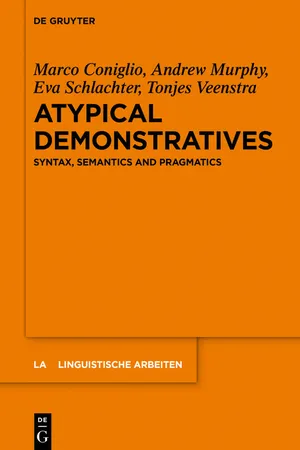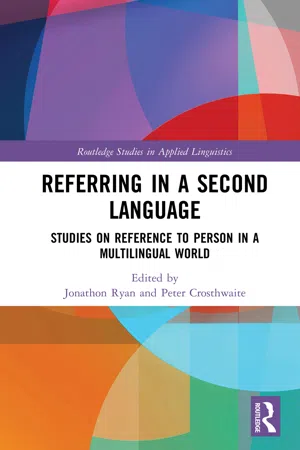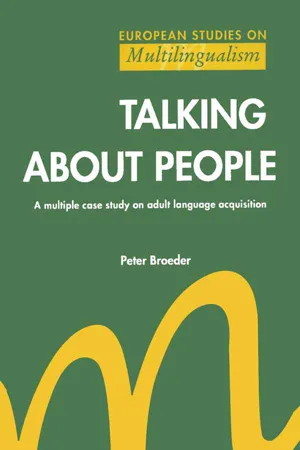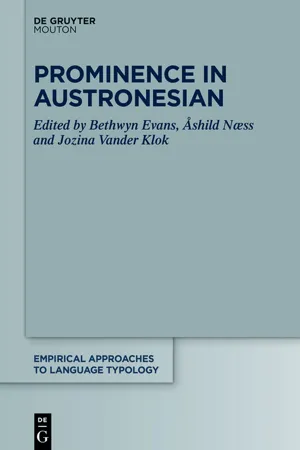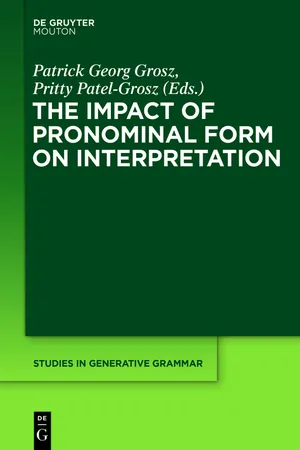Languages & Linguistics
Demonstrative Pronouns
Demonstrative pronouns are words that replace or refer to a specific noun or noun phrase. They indicate the proximity of the noun to the speaker or the listener. Common demonstrative pronouns include "this," "that," "these," and "those." These pronouns help to clarify which person or thing is being referred to in a conversation or text.
Written by Perlego with AI-assistance
9 Key excerpts on "Demonstrative Pronouns"
Learn about this page
Index pages curate the most relevant extracts from our library of academic textbooks. They’ve been created using an in-house natural language model (NLM), each adding context and meaning to key research topics.
- eBook - ePub
Atypical Demonstratives
Syntax, Semantics and Pragmatics
- Marco Coniglio, Andrew Murphy, Eva Schlachter, Tonjes Veenstra, Marco Coniglio, Andrew Murphy, Eva Schlachter, Tonjes Veenstra(Authors)
- 2018(Publication Date)
- De Gruyter(Publisher)
The basic semantic structure of demonstratives is a very simple one. As a first step, demonstratives can, certainly as far as European languages are concerned, simply be described in terms of two dimensions, viz. a deictic one, indicating the distance, visibility, altitude, position, etc. of a referent relative to the center of orientation and a content dimension, assigning a referent to a certain ontological type (object, human being or animal, place, direction, time, sex, number, etc.). These ontological categories also play an important role in the differentiation of interrogative and indefinite pronouns across languages. It is in this list of ontological categories that we find the categories ‘manner’, ‘quality’ and ‘degree’, which will play a central role in what follows. Assigning demonstratives to one of these ontological categories is, of course, only the beginning rather the end point of a precise semantic analysis, as will be shown in the second part of this article.As far as the use of demonstratives is concerned, additional synchronic distinctions are generally made. In a pragmatic analysis of demonstratives, various use types are distinguished, which – from a diachronic perspective – can also be regarded as focal points or stages in the grammaticalization of these deictic expressions: (i) an exophoric (gestural) use, where reference is made to entities in the external world surrounding the participants in a verbal interaction, providing the starting point of all further developments, (ii) an endophoric use, subsuming the two options anaphoric and cataphoric, where relations are established between the demonstratives and stretches of preceding or following discourse, (iii) a discourse use and (iv) a recognitional use, to mention only the most basic distinctions. These different uses provide the source and the stages of a variety of wide-spread processes of grammaticalization, i.e. of the development of demonstratives to markers of specific grammatical constructions (cf. Diessel 1999; König 2012; 2015; 2017). - eBook - ePub
Referring in a Second Language
Studies on Reference to Person in a Multilingual World
- Jonathon Ryan, Peter Crosthwaite, Jonathon Ryan, Peter Crosthwaite(Authors)
- 2020(Publication Date)
- Routledge(Publisher)
3 Use of demonstratives in oral narratives by Japanese learners of English Bonnie SwierzbinIntroduction
While much is known about second language (L2) learners’ use of English articles as reference devices, few studies have examined the frequency with which L2 English speakers use the demonstratives this , that , these and those , or indeed how they use them, whether for reference or other uses. An important use of demonstratives is pointing to people and objects in the speech situation. However, research on L2 acquisition of English demonstratives has mainly focused on reference in expository writing of university students (Hinkel, 2001, 2002; Jarvis, Grant, Bikowski, & Ferris, 2003; Zhang, 2015; Benell, 2018), with a smattering of studies on oral narratives (Kim, 2000; Kang, 2004; Swierzbin, 2004). A very limited set of studies (Ionin, Baek, Kim, Ho, & Wexler, 2012; Robertson, 2000) compares L2 demonstrative use to article use as evidence of first language (L1) pragmatic transfer.Although there are overlapping contexts in which both English demonstratives and articles are felicitous (Gundel, Hedberg, & Zacharski, 1993), demonstratives are a crucial part of the English system of reference, specifically because they often refer concisely and efficiently to propositions (1).(1) A: Colin was accepted to medical school.B: That ’s great!1Referring to a proposition or event with a demonstrative is more concise than a full noun phrase (NP) and more precise than a personal pronoun. Using a demonstrative in this way is what Himmelmann (1996) calls discourse deixis , one of the four categories in his universal taxonomy of demonstratives in narrative discourse. Discourse deixis is a subset of what Halliday and Hasan (1976) term text reference and extended reference ; their categories cover other forms of reference besides demonstratives and cover genres in addition to narratives. Discourse deixis is often not taught in ESL/EFL classrooms, where textbooks and teachers typically focus on basic situational use (Himmelmann, 1996) of demonstratives, also called spatial deixis, to point to and contrast physical objects or people in the speech situation in order to introduce them into the discourse. The usual lack of instruction on demonstrative use also extends to Himmelmann’s (1996) two remaining categories: tracking , where demonstratives refer to participants already established in the discourse, and recognitional , where a demonstrative serves as a reminder to the listener to search long-term memory, as in Where’s that orchid I gave you? - eBook - ePub
- Stefan Kaiser, Yasuko Ichikawa, Noriko Kobayashi, Hilofumi Yamamoto(Authors)
- 2013(Publication Date)
- Routledge(Publisher)
Chapter 5 Demonstrative/interrogative words and pronounsWhen used to point at things, demonstrative words/pronouns make a three-way distinction, which is based on proximity to the speaker or listener: ko- ‘this’ (near speaker), so- ‘that’ (near listener) and a- ‘that over there’ (distant from both). The endings attached differ according to whether what is referred to is a thing or place, is used by itself like a noun or to modify a noun, etc.However, demonstrative words/pronouns are also used to refer to previous or following context, where the above three-way distinction does not apply in quite the same way – refer to the examples in 5.2 .Question (or interrogative) words + pronouns (beginning with the syllable ‘do-’, which is equivalent to English ‘wh~’) share the same endings as the ko-/so-/a- series (see 5.2 , 18 ).Table 5.1ko-so-a-do sets of Demonstrative Pronouns and question wordsNotes * colloquially kotchi, sotchi, atchi, dotchi.** indicating degree; cf., ikura ‘how much (money)’.Others include dare ‘who’, dochira ‘which’, dore ‘which’, itsu ‘when’, ikura ‘how much (money)’, nani ‘what’ (see 5.2 and Table 5.2 ).One of the differences between dore and dochira is its use in comparative sentences, where dochira refers to a choice of two items, and dore of three or more (see 6.7 ).5.1 Demonstrative words and pronouns5.1.1 Demonstratives: spatial/temporal reference Demonstratives are used to point at, or refer to, persons, places, times, and things. Note especially example c, where kono - eBook - ePub
- Peter Broeder(Author)
- 2013(Publication Date)
- Taylor & Francis(Publisher)
Table 4.3 shows that subject pronouns are used much more frequently by native speakers of Dutch than object and possessive pronouns. This underlines the validity of predictions 7 and 8. A rather diffuse picture emerges for the relative frequency of the pronouns in object function vs. those in possessive function. There are differences between 1st role and 2nd role pronouns, between the informants, and between the internal and external corpus. As a result, frequency of use does not underline prediction 9.4.2.7
DEMONSTRATIVESIn many languages there is a close relationship between the sets of personal and possessive pronouns and the set of Demonstrative Pronouns. Table 4.6 shows the Demonstrative Pronouns in spoken Dutch (adapted from Kirsner 1979, see also Geerts et al. 1984:215–229).Table 4.6: Demonstrative Pronouns in DutchThe Demonstrative Pronouns in Dutch constitute a two-term system. The basic set distinction applies to form variants indicating “near to speaker” and those indicating “far from speaker” (cf. Anderson & Keenan 1985). In spoken Dutch the proximate demonstratives are dit (‘this’) and deze (‘this/these’), whereas the distal demonstratives are dat (‘that’) and die (‘that/those’). Demonstrative Pronouns can be used independently as well as attributively. The semantic information that is lexicalized through the Demonstrative Pronouns is number and gender. The demonstratives dit (‘this’) and dat (‘that’) encode singular “het-woord” gender, e.g. dit paard (‘this horse’); the demonstratives deze (‘this/these’) and die (‘that/those’) are used for singular “de-woord” gender, e.g. deze ezel (‘this donkey’) and for plural reference, e.g. deze ezels (‘these donkeys’) but also deze paarden (‘these horses’).4.3 THE SOURCE LANGUAGES
In this section properties of the source languages, i.e. Turkish and Moroccan Arabic, of the informants are examined as determinants of the structure of the acquisition of the Dutch pronoun system. In the Turkish and the Moroccan Arabic pronoun systems there are enclitics (suffixes) and free lexical forms. This distinction is related but not similar to the reduced/full distinction in the Dutch pronoun system.4.3.1
THE TURKISH PRONOUN SYSTEMA detailed description of colloquial Turkish can be found in Mardin (1961:24–28), Lewis (1967:67–78) and Underhill (1976:32). The basic set of free lexical forms in the Turkish pronoun system is given in Table 4.7 - eBook - ePub
- Laura Becker(Author)
- 2021(Publication Date)
- De Gruyter(Publisher)
4.1: Grammaticalization path from demonstrative to general noun marker 1 The relevant part is the development between stage 0 (demonstratives) and stage I (definite articles) and the distinction of the properties of demonstratives on the one hand and definite articles on the other. In addition, even though not being part of the general grammaticalization path shown in Figure 4.1, anaphoric, weak definite, and recognitional articles need to be distinguished from the other two types of markers as well. The demonstrative is understood as a deictic element, typically used for spatial deixis, indicating the relative position of an object with respect to the discourse situation with the aim to draw the hearer’s attention towards the referent of this object. This use is called exophoric (cf. Diessel 1999 : 94-95). Demonstratives with a primarily exophoric function can often be extended to anaphoric functions (Diessel 1999 : 96). This use is also called endophoric (cf. Diessel 1999 : 95-105). Exophoric and endophoric uses are thus two diferent types of deixis. For the sake of clarity, I use the term “deixis” only to refer to spatial deixis and treat exophoric uses as “anaphora”. To be precise, deixis in this sense refers to physical perception and attention drawing. The prototypical deictic use of demonstratives can usually be accompanied by a pointing gesture (Diessel 2013 : 243). This link between pointing gestures and demonstratives is well known in the linguistic literature (e.g. Brugmann 1904, Bühler 1934, Clark 1996, Eriksson 2009, Levinson 2004) and was often tied to the spatial deictic function of demonstratives. Diessel (2013: 243) points out that the function of such demonstratives is not only spatial location, but more importantly, drawing the hearer’s attention towards an object in the discourse situation - eBook - ePub
- Bethwyn Evans, Åshild Næss, Jozina Vander Klok, Bethwyn Evans, Åshild Næss, Jozina Vander Klok(Authors)
- 2024(Publication Date)
- De Gruyter Mouton(Publisher)
temenin telo ‘like that’, which refers to the contents of an immediately following utterance or stretch of discourse. An example of this use can be found in sentence (12).(12)upe pul me rang la remenin telo. . .[u] A=pepul=[Ø] Ome ta-ng la temenin 3du =pfv tell=3sg come clf-1sg .poss go.to like te-lo lig-dem.dist ‘They told me as follows. . .’ (LK100411_0056)The intermediate demonstrative, in its discourse deictic function, seems to have acquired evaluative and recapitulative overtones: it occurs frequently, following the third singular pronoun i, both at the end of a narrative and at a narrative peak (Longacre 1983 ; Margetts 2016 ). The phrases i yo and i teyo have a sense of ‘Okay’ or ‘That’s it’ – see examples (13) and (14). A recapitulative analysis is supported by the fact that there is most often a short pause between the phrase with the demonstrative and the main part of the utterance.(13)i o, ningning tang oi yo ning~ning ta-ng yo 3sg dem.int red ~view clf- 1sg .poss dem.int ‘That’s it. That’s my point of view [on the matter just discussed].’ (OL040311_0047)(14)i reo, pwapwaen songanum tui reai te-yo pwapwae-n songan.um ta-ui te-ya 3sg lig-dem.int story-3sg .poss marriage clf-1du.excl.poss lig-foc ‘That’s it, the story of our marriage.’ (KM060111_0098)Thus, all demonstratives (proximate, intermediate and distal) have dual roles as situational and discourse deictic markers. In discourse, they still act as pointers, just as they do in their situational use, but on a more abstract level. Intermediate demonstratives draw the attention of the addressee by emphasising the element they modify and refer back as anaphors, not to an individual entity but to a stretch of discourse. This has probably led to their reanalysis and use as markers of definiteness and of topicalised constituents. Proximate and distal demonstratives have acquired a slightly different role as cataphors, referring forward.Some instances of the intermediate demonstrative cannot readily be classified as anaphors. Instead, they modify newly introduced participants; an example can be found in (15). It comes from the introduction to a traditional legend about two stones fighting.8 The storyteller is explaining why he is the person entitled to tell this story, as it was his direct ancestor who witnessed this fight, and got up close to one of the stones. This ancestor is introduced into the discourse in the utterance below, with the phrase yamat teyo - eBook - ePub
- Elizabeth Pearce(Author)
- 2015(Publication Date)
- De Gruyter Mouton(Publisher)
463.4.2. Modifying deictic/anaphoric demonstratives
3.4.2.1 . Overview
Table 3-1 sets out the basic proximate and distant demonstrative forms, singular and plural, along with the forms which occur most often in “previous mention” contexts, corresponding to English ‘that’/those’ and ‘the’. I will use the label ‘demonstrative’ as a cover term for all of the Unua forms in Table 3-1 .Table 3-1 : Unua demonstrative modifiersIn Table 3-1 , the representation of number as ‘SG’ versus ‘PL’ is not exactly accurate since it is the ‘SG’ form that is used when two entities are being identified by the noun phrase: ‘SG’ is therefore here a cover term for ‘fewer than three in number’. The table shows that, depending on the particular demonstrative, there are alternations in the presence/absence of plural marking, identifiable as an infix of the form -ar -. The vowels of the demonstratives can be seen to be in parallel with those of the locational Demonstrative Pronouns (section 7.2.5 ). These latter encode a three-way spatial contrast as:(36)ien ‘here’ iog ‘there’ iag ‘over there’ Both the PROX demonstrative nge and ien ‘here’ have the vowel /e/; the vowel /a/ appears in the forms encoding “greater distance”: ngag and iag . The vowel /a/ is present also in the more distant previous mention demonstrative nga . The vowel /o/ occurring in the “middle distance” locational demonstrative iog occurs also in the general previous mention demonstrative ngo . Thus it would appear that the more neutral demonstrative in terms of relative distance has come to be grammaticalized to have the function of a general previous mention determiner. Whilst both nga and ngo have previous mention functions, I have chosen to gloss the more marked member of this pair as ‘DEM’, reserving the gloss ‘the’ for the unmarked previous mention demonstrative ngo - eBook - ePub
- Patrick Grosz, Pritty Patel-Grosz, Patrick Grosz, Pritty Patel-Grosz(Authors)
- 2016(Publication Date)
- De Gruyter Mouton(Publisher)
The World Atlas of Language Structures Online . Leipzig: Max Planck Institute for Evolutionary Anthropology. (Available online at http://wals.info/chapter/43, Accessedon 2014-11-05.)Bosch, Peter. 2013. Anaphoric reference by Demonstrative Pronouns in German. Presented at the Workshop on the Impact of Pronominal Form on Interpretation , Universität Tübingen, Nov. 2013Bosch, Peter, Graham Katz, and Carla Umbach. 2007. The Non-subject Bias of German Demonstrative Pronouns. In M. Schwarz-Friesel, M. Consten & M. Knees (eds.) Anaphors in Text: Cognitive, Formal and Applied Approaches to Anaphoric Reference . 145–164Chierchia, Gennaro. 1998. Reference to kinds across languages. Natural Language Semantics 2: 339–405.Davidson, Kathryn. 2013. ‘And’ or ‘Or’: General Use Coordination in ASL. Semantics & Pragmatics, 6(4), 1–44.Davidson, Kathryn and Deanna Gagne. 2014. Vertical representation of quantificational domains. Presented at Sinn und Bedeutung , Basque Country, Spain, Sep 2013.Dayal, Veneeta. 2004. Number marking and (in)definiteness in kind terms. Linguistics and Philosophy 27 (3): 393–450.Elbourne, Paul. 2005. Situations and Individuals . Cambridge, Mass.: MIT Press.Elbourne, Paul. 2008. Demonstratives as individual concepts. Linguistics and Philosophy , 31(4): 409–466Frege, Gottlob. 1960 [1893]. On Sense and reference. Reprinted in P. Geach and M. Black, eds., Translations from the Philosophical Writings of Gottlob Frege . Oxford: Blackwell.Hankamer, Jorge and Ivan Sag. 1976. Deep and surface anaphora. Linguistic Inquiry 7: 391–428.Heim, Irene. 1982. The Semantics of Definite and Indefinite Noun Phrases . Doctoral dissertation, University of Massachusetts, Amherst.Heim, Irene. 1985. Direct reference explained away. Ms. University of Texas at Austin.Heim, Irena and Kratzer, Angelika. 1998. Semantics in Generative Grammar - eBook - ePub
- Collins Dictionaries(Author)
- 2016(Publication Date)
- Collins(Publisher)
Pronouns What is a pronoun? A pronoun is a word you use instead of a noun, when you do not need or want to name someone or something directly, for example, it , you , none . ➤ There are several different types of pronoun: ● Personal pronouns such as I, you, he, her and they, which are used to refer to you, the person you are talking to, or other people and things. They can be either subject pronouns ( I, you, he and so on) or object pronouns ( him, her, them, and so on). ● Possessive pronouns like mine and yours, which show who someone or something belongs to. ● Indefinite pronouns like someone or nothing, which refer to people or things in a general way without saying exactly who or what they are. ● Relative pronouns like who , which or that, which link two parts of a sentence together. ● Interrogative pronouns like who , what or which, which are used in questions. ● Demonstrative Pronouns like this or those, which point things or people out. ● Reflexive pronouns, a type of object pronoun that forms part of Spanish reflexive verbs like lavarse (meaning to wash ) or llamarse (meaning to be called ). ➪ For more information on Reflexive verbs , see page 91. ➤ Pronouns often stand in for a noun to save repeating it. I finished my homework and gave it to my teacher. Do you remember Jack? I saw him at the weekend. ➤ Word order with personal pronouns is usually different in Spanish and English.Passage contains an image
42 Pronouns Personal pronouns: subject What is a subject pronoun? A subject pronoun is a word such as I, he, she and they , that carries out the action expressed by the verb. Pronouns stand in for nouns when it is clear who or what is being talked about, for example, My brother isn’t here at the moment. He’ll be back in an hour.
